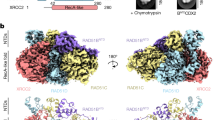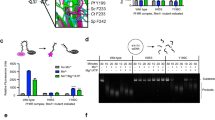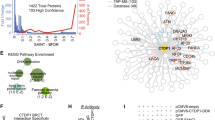Abstract
The C-terminal BRCT region of BRCA1 is essential for its DNA repair, transcriptional regulation and tumor suppressor functions. Here we determine the crystal structure of the BRCT domain of human BRCA1 at 2.5 Å resolution. The domain contains two BRCT repeats that adopt similar structures and are packed together in a head-to-tail arrangement. Cancer-causing missense mutations occur at the interface between the two repeats and destabilize the structure. The manner by which the two BRCT repeats interact in BRCA1 may represent a general mode of interaction between homologous domains within proteins that interact to regulate the cellular response to DNA damage. The structure provides a basis to predict the structural consequences of uncharacterized BRCA1 mutations.
This is a preview of subscription content, access via your institution
Access options
Subscribe to this journal
Receive 12 print issues and online access
$189.00 per year
only $15.75 per issue
Buy this article
- Purchase on Springer Link
- Instant access to full article PDF
Prices may be subject to local taxes which are calculated during checkout




Similar content being viewed by others
Accession codes
References
Miki, Y. et al. Science 266, 66–71 (1994).
Futreal, P.A. et al. Science 266, 120–122 (1994).
Friedman, L.S. et al. Nature Genet. 8, 399–404 (1994).
Gayther, S.A. et al. Am. J. Hum. Genet. 58, 451–456 (1996).
Koonin, E.V., Altschul, S.F. & Bork, P. Nature Genet. 13, 266–268 (1996).
Callebaut, I. & Mornon, J.P. FEBS Lett. 400, 25–30 (1997).
Cantor, S.B. et al. Cell 105, 149–160 (2001).
Deng, C.X. & Brodie, S.G. Bioessays 22, 728–737 (2000).
Terwilliger, T.C. & Berendzen, J. Acta Crystallogr. D 55, 849–861 (1999).
Zhang, X. et al. EMBO J. 17, 6404–6411 (1998).
Lee, J.Y. et al. EMBO J. 19, 1119–1129 (2000).
Nash, R.A., Caldecott, K.W., Barnes, D.E. & Lindahl, T. Biochemistry 36, 5207–5211 (1997).
Dulic, A. et al. Biochemistry 40, 5906–5211 (2001).
Scully, R. et al. Mol. Cell 4, 1093–1099 (1999).
Yu, X., Wu, L.C., Bowcock, A.M., Aronheim, A. & Baer, R. J. Biol. Chem. 273, 25388–25392 (1998).
Li, S. et al. J. Biol. Chem. 274, 11334–11338 (1999).
Yarden, R.I. & Brody, L.C. Proc. Natl. Acad. Sci. USA 96, 4983–4988 (1999).
Chapman, M.S. & Verma, I.M. Nature 382, 678–679 (1996).
http://www.nhgri.nih.gov/Intramural_research/Lab_transfer/Bic/
Eriksson, A.E. et al. Science 255, 178–183 (1992).
Otwinowski, Z. & Minor, W. Methods Enzymol. 276, 307–325 (1997).
Cowtan, K. In Joint CCP4 and ESF-EACBM newsletter on protein crystallography 31, 34–38 (1994).
Jones, T.A., Zou, J.Y., Cowan, S.W. & Kjeldgaard Acta Crystallogr. A 47, 110–119 (1991).
Brünger, A.T. et al. Acta Crystallogr. D 54, 905–921 (1998).
Collaborative Computational Project, Number 4. Acta Crystallogr. D 50, 760–763 (1994).
Winn, M.D., Isupov, M.N. & Murshudov, G.N. Acta Crystallogr. D 57, 122–133 (2001).
Laskowski, R.A., MacArthur, M.W. & Thornton, J.M. Curr. Opin. Struct. Biol. 8, 631–639 (1998).
Kraulis, P.J. J. Appl. Crystallogr. 24, 946–950 (1991).
Merritt, E.A. & Bacon, D.J. Methods Enzymol. 277, 505–524 (1997).
POV-Team. Persistence of Vision Ray Tracer v.3.1 http://www.povray.org (1999).
Acknowledgements
We would like to thank L. Gaudreau for the gift of the BRCA1(1,568–1,863) expression plasmid and helpful discussions, B. Mark and J. Lamoureux for help with X-ray data collection, and K. Brister and the staff of APS BioCARS for excellent technical support during synchrotron data collection. This work was supported by operating grants from the Canadian Institutes of Health Research, the Canadian Breast Cancer Research Initiative and the Alberta Heritage Foundation for Medical Research.
Author information
Authors and Affiliations
Corresponding author
Rights and permissions
About this article
Cite this article
Williams, R., Green, R. & Glover, J. Crystal structure of the BRCT repeat region from the breast cancer-associated protein BRCA1. Nat Struct Mol Biol 8, 838–842 (2001). https://doi.org/10.1038/nsb1001-838
Received:
Accepted:
Issue Date:
DOI: https://doi.org/10.1038/nsb1001-838
This article is cited by
-
Functional analyses of rare germline BRCA1 variants by transcriptional activation and homologous recombination repair assays
BMC Cancer (2023)
-
Synthesis and characterization of some benzidine-based azomethine derivatives with molecular docking studies and anticancer activities
Chemical Papers (2023)
-
Synthesis, Identification, Antibacterial Activity, ADME/T and 1BNA-Docking Investigations of 8-Quinolinol Analogs Bearing a Benzimidazole Moiety
Arabian Journal for Science and Engineering (2022)
-
Regulation of BRCA1 stability through the tandem UBX domains of isoleucyl-tRNA synthetase 1
Nature Communications (2022)
-
Fanconi anemia pathway as a prospective target for cancer intervention
Cell & Bioscience (2020)



